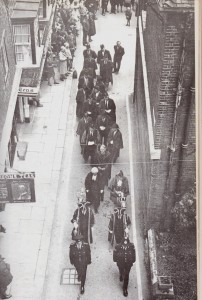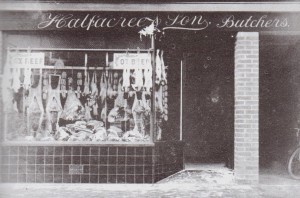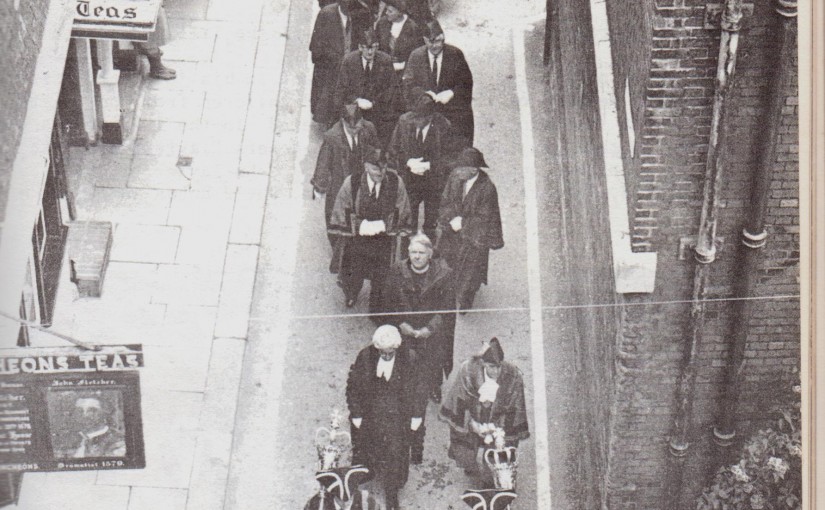Who were the driving forces in the town fifty years ago? Who were in power at Rye Town Hall in the 1960’s? What was it like to live in a democratic Rye that ran its own affairs and was responsible for its own planning?1965 and 66 were great years for Rye. The Borough Council was made up of twelve elected Councillors and four Aldermen nominated by the Councillors. Alderman John Hacking, farmer, was Mayor. He was hard working and influential, leading a group of excellent men and women who were all laboring to benefit Rye and the people of Rye.

Alfred Homer, grocer, the outgoing Mayor was one of my personal favorites. He was a man of the people. He loved Rye and everyone who lived in the town, he was absolutely genuine and I would bet he did not have one enemy in the world. It was Alfred that was responsible for the narrow footpath that runs through the Landgate Tower. It was thought that the road was too narrow at that point to allow for a path but Alfred persisted. I held the tape for him one cold November morning when he measured the width of the road. He stuck to his guns and had his own way in the end.
John Smith the Town Clerk was another remarkable man. Guiding the Council through the maze of paperwork that seems to hold up every forward step. Red tape is ten times worse today and Rye is fortunate to have another great Town Clerk in Richard Farhall to sort out the paper chase.
Stan Borne was a further powerful figure on Rye Council. He had a reputation of getting things done and like Alfred Horner, he was very popular with the voters, topping the poll at every election on which he stood.
Phil Ellis, ironmonger, was a fatherly figure who got things moving. As with most Rye Councillors he was well liked, a man you could take your problems to and be sure that something would be done about them.
Geoff Scotcher, builder, a very practical man who had great vision. He was responsible in great part for the Badger Gate building that has been such a boon to Rye’s senior citizens. There was originally a live in Warden, taken away in later years by Rother District Council to the detriment of the people of Rye. Geoff was also instrumental in the planning of the North Salts site for seventy-two dwellings for which building started in 1965.
Just five office staff and eight full time workers carried out the decisions of Rye Borough Council. They were employed by the council and looked after the Town Salts and Cricket Salts, Cemetery, Gungarden (which really was a garden in those days), the roads within the town and pavements, water throughout the town, toilets and rubbish collection. They kept the streets clean and cleared snow in the winter.
Other Good Influences
There were men outside the council who had great influence on town affairs. Jim Foster of Adams is one that springs to mind. His work with the Methodist Choir and many other local movements made him a chap to look up to and respect. He was another 100% genuine figure in the same mould as Alf Horner.
The Vicar of Rye John Williams, later Canon John Williams was a vigorous character. He had been a member of 617 (Dambusters) Squadron during the War. His energetic leadership at St. Mary’s had the church packed to the seams on many occasions. His friendship with another great Rye Church leader Father Richard resulted in the first catholic priest (Father Richard) celebrating communion in a protestant church since the reformation. I am not a regular church goer myself but I was friends with both men and I must record that these were the two greatest people I have met in my lifetime. I can still recall the words spoken by Father Richard in St. Mary’s when there was a special all denomination service when he was called away to Liverpool after many years at St. Anthony’s in Rye.
“For me this town has a special place in my heart” these words echoed across the great church, where the only sound was the rhythmic tic-toc of the pendulum “Tonight for me is the inevitable hour, the hour In which I must say farewell”.
What was happening in 1965 & ‘66?
“Rye’s Own” was born. The first issue going for sale on October 20 1965. This was the November number. In the early years the magazine appeared in the shops ten days before the month on the cover. This changed in 1968 to the first day of the month. This practice has continued to this day.
Rye Bonfire Boys were having a purple patch. Humphrey Lestocq, star of stage, screen and radio, had moved to Rye. His work with the Society resulted in all kinds of stars being cajoled into becoming Rye Fawkes over the next few years. Soap Star Pamela Duncan (Sister Doughty of Emergency Ward 10) 1965 and Pik-Sen Lim (from the same soap) in 1966 drew in large crowds. (In those days the name of Rye Fawkes was published before the event).
Rye Horse Show was an annual event held at Gateborough Farm . Mrs. Hacking was the leading light in the organizing of the show. I was pleased to see that the Horse Show was revived in 2004, after several years absence from the Rye calendar. Now called the Rye Country Fair, Horse and Dog Show it has become a really popular fixture again.
Rye Movie Society was the talk of the town. They won the East Sussex Film Competition three years running from 1965 on. Their public shows were packed out. At one time they had to use the Assembly Hall at the Grammar School to accommodate the numbers that crowded in to see the local newsreel films they made. Fred Masters, Jeffery Waters, Roy Miles, Clive Wall, Joan Camier and David Smeed were some of the leading lights in the Society.
Rye Sports Day was going through a successful period. Frank Clarke and Frank Brann guided the event, which was first held in 1899, through this period. The 1965 and ‘66 events were very well supported by competitors and public alike. The Rye Wheeler’s provided local interest. In 1966 they won the Gasson Team Shield for the first of three successive times, a feat that had never been achieved in the history of the competition.
Rye United rode high in Division One of the Sussex County League. They were third in 1965. The Bill ‘Blower’ Pierce era was over but most of the players still lived in the town. Now Rye are again at the top end of the Division One table but alas, few of the players in the first team are home grown. This is a sign of the times, the top Premiership teams are made up mainly of players that were not even born in the country!
Small Businesses
In 1965 Rye was a town of small shopkeepers. What fine shops they were too. Fifteen grocers and greengrocers, three butchers, three wet fish shops, four shoe shops, ten clothes shops, three ironmongers, eight newsagents, three television shops, four white electric shops, three record shops, two toy shops, the list is endless. Anything anyone ever wanted could be purchased in Rye. The biggest retail outlet was Woolworths.
The grocers still had delivery boys. A list was dropped into the grocer, he got up the order and the boy delivered. Payment was made when the new order was put in the following week. You listed what you wanted and the grocer did the rest AND gave a weeks credit.
Mrs. Griffiths was the popular proprietor of Rose Anne dress shop (still run today by daughter Rosemary) She arranged a fantastic annual fashion show at the George Hotel using local women as models, it was a very popular show and generated lots of business for the High Street establishment.

Television and Electrical businesses were plentiful, Tim Healey, Vic Moore, Arthur Wilson, Jim Hollands, Roy Beckerson and the Electric Showrooms supplied virtually every home in Rye and the surrounding villages with every form of electrical appliance available. There was no need to go to Hastings or Ashford, the same choice and prices were offered in town. All goods were controlled by retail price maintenance, a bag of sugar cost the same wherever you bought it. Choice was made by service and selection, not because there was a penny to be saved. Inflation was negligible. A Mars Bar cost 6d. from 1960 to 1972 the year RPM was abolished by a majority of one in a free vote in Parliament. The argument was that free competition would make prices cheaper! All it has resulted in nation wide is very few businesses taking most of the profits and hundreds of thousands of small shops going out of business.
Market Day (Cattle Market) on Wednesdays drew in farmers from far and wide. Leslie Stutely of Vidler & Co. conducted the auction, which by this time, consisted mainly of sheep. The Thursday General Market started in 1966 and brought thousands into the town every week. There was mixed reaction from the shops, cafe’s did well but some Rye traders claimed the large attendance at the Market was not reflected in their takings. On balance it was probably beneficial but some shopkeepers will still dispute this view.
1966 saw the greatest day in the history of Rye for 400 years. H.R.H. Queen Elizabeth and Prince Phillip made an official visit to the town on their tour of the South East.
They spent time in the Town Hall and St. Mary’s, were presented with a trug of Rye Bay bloaters by fisherman John Button and proceeded through the cobbled streets of the town in magnificent limousines that had to be maneuvered back and forth to get round the corner of Church Square and West Street. They eventually made their was down Mermaid Street, which was packed with cheering, flag waving crowds and off towards Winchelsea.
It was almost four hundred years on from the day that the first Queen Elizabeth had visited Rye. She had paid tribute to the Ancient Town which formed an important part in the defending the Realm against invaders since the end of the 12th. century.
These were halcyon days for Rye and the nation. A visit to the town by the Royals, full employment and prosperity and the momentous feat of the England Football Team in winning the World Cup.
Perhaps the triumph of our Olympians will signal the start of more good times ahead.
